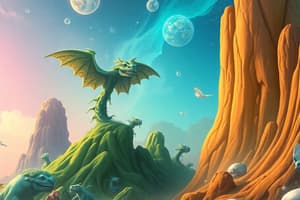Podcast
Questions and Answers
What specialized cells in cyanobacteria are responsible for fixing atmospheric nitrogen?
What specialized cells in cyanobacteria are responsible for fixing atmospheric nitrogen?
- Endospores
- Flagella
- Chloroplasts
- Heterocysts (correct)
Which of the following describes chemosynthetic autotrophic bacteria?
Which of the following describes chemosynthetic autotrophic bacteria?
- They are completely dependent on organic substances.
- They lack any means of energy production.
- They utilize light energy for growth.
- They oxidize inorganic substances for ATP production. (correct)
What is the primary method of reproduction in bacteria?
What is the primary method of reproduction in bacteria?
- Fission (correct)
- Binary fusion
- Budding
- Mitosis
What is one significant role of heterotrophic bacteria in nature?
What is one significant role of heterotrophic bacteria in nature?
What characterizes Mycoplasma organisms?
What characterizes Mycoplasma organisms?
What type of organisms are dinoflagellates mostly classified as?
What type of organisms are dinoflagellates mostly classified as?
What is the function of the pellicle in euglenoids?
What is the function of the pellicle in euglenoids?
Which of the following statements about slime moulds is correct?
Which of the following statements about slime moulds is correct?
What distinguishes protozoans from other protists?
What distinguishes protozoans from other protists?
What happens to red dinoflagellates when they undergo rapid multiplication?
What happens to red dinoflagellates when they undergo rapid multiplication?
Which kingdom includes organisms that are prokaryotic?
Which kingdom includes organisms that are prokaryotic?
In which kingdom are organisms primarily heterotrophic and multicellular?
In which kingdom are organisms primarily heterotrophic and multicellular?
What type of cell wall do Plantae have?
What type of cell wall do Plantae have?
Which kingdom is characterized by the absence of a nuclear membrane?
Which kingdom is characterized by the absence of a nuclear membrane?
Which kingdom includes organisms that are autotrophic and can perform photosynthesis?
Which kingdom includes organisms that are autotrophic and can perform photosynthesis?
What type of body organization do organisms in the Animalia kingdom have?
What type of body organization do organisms in the Animalia kingdom have?
Which kingdom is known for having a mode of nutrition that includes saprophytic and parasitic methods?
Which kingdom is known for having a mode of nutrition that includes saprophytic and parasitic methods?
Which of the following kingdoms contains organisms with eukaryotic cell types?
Which of the following kingdoms contains organisms with eukaryotic cell types?
What distinguishes viruses from living organisms?
What distinguishes viruses from living organisms?
What happens to a host cell once it is infected by a virus?
What happens to a host cell once it is infected by a virus?
Why are viruses not included in Whittaker's five kingdom classification?
Why are viruses not included in Whittaker's five kingdom classification?
What term is derived from Latin meaning 'venom or poisonous fluid'?
What term is derived from Latin meaning 'venom or poisonous fluid'?
Which of the following is NOT a characteristic feature of viruses?
Which of the following is NOT a characteristic feature of viruses?
What type of spores do deuteromycetes produce?
What type of spores do deuteromycetes produce?
Which of the following is not a characteristic of the kingdom Plantae?
Which of the following is not a characteristic of the kingdom Plantae?
In the life cycle of plants, what is the term for the alternating phases?
In the life cycle of plants, what is the term for the alternating phases?
Which of the following examples represents an insectivorous plant?
Which of the following examples represents an insectivorous plant?
What is a significant characteristic of organisms in the kingdom Animalia?
What is a significant characteristic of organisms in the kingdom Animalia?
Flashcards
Five Kingdoms
Five Kingdoms
Classification based on cell type, cell wall, nuclear membrane, body organization, and nutrition mode.
Kingdom Monera
Kingdom Monera
Prokaryotic, unicellular organisms like bacteria and cyanobacteria.
Cyanobacteria
Cyanobacteria
Unicellular, colonial, or filamentous bacteria that can fix atmospheric nitrogen.
Chemosynthetic bacteria
Chemosynthetic bacteria
Signup and view all the flashcards
Heterotrophic bacteria
Heterotrophic bacteria
Signup and view all the flashcards
Fission
Fission
Signup and view all the flashcards
Mycoplasma
Mycoplasma
Signup and view all the flashcards
Dinoflagellates
Dinoflagellates
Signup and view all the flashcards
Euglenoids
Euglenoids
Signup and view all the flashcards
Slime molds
Slime molds
Signup and view all the flashcards
Protozoans
Protozoans
Signup and view all the flashcards
Deuteromycetes
Deuteromycetes
Signup and view all the flashcards
Kingdom Plantae
Kingdom Plantae
Signup and view all the flashcards
Insectivorous plants
Insectivorous plants
Signup and view all the flashcards
Cuscuta
Cuscuta
Signup and view all the flashcards
Alternation of generations
Alternation of generations
Signup and view all the flashcards
Kingdom Animalia
Kingdom Animalia
Signup and view all the flashcards
Holozoic nutrition
Holozoic nutrition
Signup and view all the flashcards
Viruses
Viruses
Signup and view all the flashcards
Bacteriophage
Bacteriophage
Signup and view all the flashcards
Study Notes
Five Kingdoms Classification
- Characterizes organisms based on cell type, cell wall composition, nuclear membrane presence, body organization, and mode of nutrition.
- Includes Monera (prokaryotic, unicellular), Protista (eukaryotic, unicellular/colonial), Fungi (eukaryotic, multicellular/loose tissue), Plantae (eukaryotic, multicellular, autotrophic), and Animalia (eukaryotic, multicellular, heterotrophic).
Kingdom Monera
- Comprises prokaryotic organisms like bacteria and cyanobacteria.
- Cyanobacteria (blue-green algae) are unicellular, colonial, or filamentous, found in various environments, some fix atmospheric nitrogen (e.g., Nostoc, Anabaena).
- Chemosynthetic bacteria oxidize inorganic substances for energy, playing a role in nutrient cycling.
- Heterotrophic bacteria are abundant decomposers, some beneficial (e.g., curd production, antibiotic production), others pathogenic (e.g., causing cholera, typhoid, tetanus).
- Bacteria reproduce mainly by fission and can produce spores under stress, some exhibit primitive DNA transfer.
- Mycoplasma lack cell walls.
Kingdom Protista
- Dinoflagellates: mostly marine, photosynthetic, possess cellulose plates and two flagella, some cause red tides (Gonyaulax).
- Euglenoids: freshwater, flexible pellicle instead of cell wall, two flagella, photosynthetic in sunlight, heterotrophic in darkness, pigments similar to higher plants (Euglena).
- Slime molds: saprophytic, move along decaying matter forming plasmodium, form fruiting bodies with spores under stress.
- Protozoans: heterotrophic, predators or parasites, considered primitive animal relatives.
Kingdom Fungi
- Deuteromycetes: reproduce asexually by conidia, septate and branched mycelium, saprophytes, parasites, or decomposers (Alternaria, Colletotrichum, Trichoderma). Note that once sexual stages were discovered, many were reclassified into Ascomycetes and Basidiomycetes.
Kingdom Plantae
- Includes eukaryotic, chlorophyll-containing organisms (plants).
- Some are partially heterotrophic (insectivorous plants like Bladderwort and Venus fly trap, or parasites like Cuscuta).
- Plant cells have eukaryotic structure with chloroplasts and cellulose cell walls.
- Includes algae, bryophytes, pteridophytes, gymnosperms, and angiosperms.
- Exhibit alternation of generations (diploid sporophyte and haploid gametophyte phases).
Kingdom Animalia
- Heterotrophic, multicellular eukaryotes lacking cell walls.
- Depend on plants for food, digest food internally, store food as glycogen or fat.
- Holozoic nutrition (ingestion), definite growth pattern, and shape.
- Higher forms have sensory and neuromotor mechanisms, most are capable of locomotion.
- Sexual reproduction with copulation and embryological development.
Acellular Organisms
- Viruses: non-cellular, inert crystalline structure outside host cells, infect cells to replicate, considered non-living by some. (Tobacco Mosaic Virus (TMV), Bacteriophage).
- Viroids and prions are also mentioned, but not detailed.
- Lichens are not explicitly detailed in the five kingdom classification.
Studying That Suits You
Use AI to generate personalized quizzes and flashcards to suit your learning preferences.




